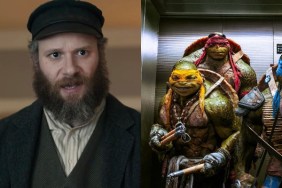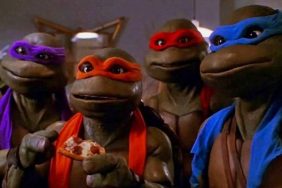Hollywood insiders are beginning to notice a very disturbing trend this summer. Despite the massive success of Captain America: Civil War, all of the other sequels are tanking, and tanking hard.
As of this moment, it looks like Neighbors 2 will be lucky to top $100 million, and Alice Through the Looking Glass – the follow-up to a film that grossed over $1 billion – looks like it will take in a relatively small fraction of that amount. And while Teenage Mutant Ninja Turtles: Out of the Shadows and X-Men: Apocalypse aren’t exactly “flops,” they’re both performing well under the box office expectations set by their predecessors.
It’s a disappointing development for movie studios, who have become increasingly reliant on sequels in this, “The Age of the Franchise.” Each of these films was a follow-up to a blockbuster success that seemed to prove that audiences wanted more of each particular brand of shenanigans. So what the hell went wrong?
The industry pundits are all making their case right now, and some of the arguments are reasonable. Perhaps it really is a case of unrealistic expectations, for example. But I think we can debate all we want and still come to the simple, undeniable conclusion that just because one movie is a hit, doesn’t mean that audiences necessarily want another film just like it.
That may be a frustrating concept for industry types who like to think of the film industry in terms of simple mathematics (“If Film A is popular, then Film A: Part 2 will be popular. It’s practically a science!”), but of course art doesn’t work that way. And this summer has given us two stellar examples of how sequel planning can go wrong.

Universal Pictures
Also: Dear Fox: Just Reboot the X-Men Already (You Know You Want To)
The first comes in the form of Neighbors 2: Sorority Rising, which was a follow-up to a film that most people liked, but a film that in no way demanded a sequel. It was the story of two adults who were clinging to their youthful identities, who eventually embraced the next phase of their life when a frat house moves in next door. Quite simply, from a plot perspective, no aspect of the original Neighbors left audiences dangling, wondering what happened next.
In fact, the characters grew up so much over the course of the first movie that Neighbors 2 had to do backflips just to get them all in the same situation, all over again. In Neighbors, Zac Efron eventually made peace with his rival neighbors, played by Seth Rogen and Rose Byrne, but then he literally forgot about that plot point in the follow-up, because if he didn’t they couldn’t recycle the exact same comedic set pieces they had before.

Universal Pictures
With no storyline to continue, and trailers that only promised the exact same movie but with a sorority instead of a frat house, it only makes sense that Neighbors 2 didn’t come across as a “must see,” even to fans of the first movie. Sadly, the best and most original part of the movie – the sorority subplot, which was new and funny and surprisingly socially relevant – was minimized in the advertising in favor of assurances that Neighbors 2 would play out exactly the same as Neighbors 1. Perhaps treating the sequel as a second course instead of the same old comfort food would have helped it find a larger audience.
(It’s not a summer movie, but I would argue that this “Done in One” effect also had an impact on Allegiant, the third film in the Divergent franchise, which – to those unfamiliar with the books, at least – came after a second film that seemed to wrap the whole story up in a tidy bow, if only in a Twilight Zone kind of way. Audiences got everything they needed, so coming back for more seemed optional.)

Walt Disney
The other example(s) we should be looking at are Alice Through the Looking Glass and Teenage Mutant Ninja Turtles: Out of the Shadows, two sequels to two films that made a ton of money but that nobody seemed to actually “like” very much. In fact, both Alice in Wonderland (40) and Teenage Mutant Ninja Turtles (2014) are often held up as examples of how NOT to tell a story in the modern age of visual effects. Alice emphasized spectacle over character and story, and Turtles emphasized product placement instead.
Both of the “original” films (as original as they can be, since they were both reboots) made money based on a curiosity factor, nostalgia and certainly a bit of spectacle. But once those novelties wore off, audiences were left with characters who had very little emotional impact, whose stories did not become a part of our lives in the that way more dramatically impactful blockbusters do. We have grown attachments to the cast of the Fast & Furious movies, for example, but the abrasive new Turtles and the bizarre deviations from Lewis Carroll’s original creations only kept us at arm’s length, demanding that audiences look “at” them rather than become personally involved “with” them.
(I should note, however, that Teenage Mutant Ninja Turtles: Out of the Shadows actually FIXED a lot of of the problems of the first film, but it seems the damage has been done, and that audiences weren’t terribly interested in giving the series a second chance.)

Paramount Pictures
Also: ‘Teenage Mutant Ninja Turtles: Out of the Shadows’ Un-Ruined My Childhood
Of course, in Hollywood, audiences can only vote with their money, but maybe they should get more than one vote. Studios only determine whether people want a sequel based on how much money the original made. If the popularity of a franchise only subsides in the months and years after the original release, the studios have no way of knowing about it. (Unless of course they asked somebody, but that’s crazy talk.)
Time, as I have said multiple times before, is the only critic that matters. Lots of movies are successful for a little while and then fade almost immediately into obscurity. (Do you remember when George of the Jungle was a blockbuster? And do you remember when the sequel most definitely wasn’t?) The films that make a lasting impression are the ones that have value, not just to audiences but also to studios.
This may not be a terribly useful lesson for Hollywood to learn – i.e. wait a while before you green light a sequel to a successful motion picture (I’m sure the investors would love that approach) – but if we don’t at least keep it in mind we’re going to keep getting sequels that nobody asked for, and the studios are going to keep being surprised when doing the same thing over and over again doesn’t yield different results.
William Bibbiani (everyone calls him ‘Bibbs’) is Crave’s film content editor and critic. You can hear him every week on The B-Movies Podcast and Canceled Too Soon, and watch him on the weekly YouTube series Most Craved, Rapid Reviews and What the Flick. Follow his rantings on Twitter at @WilliamBibbiani.
Summer Blockbusters That Took Everyone By Surprise:
Top Photo: Paramount Pictures
10 Unexpected Summer Blockbusters
-
Easy Rider (July 14th, 1969)

When Dennis Hopper's Easy Rider was released, it was meant to be a secret indie subversion that sneaked its way into theaters. Not only did it make a huge amount of money, but it changed all of filmmaking culture for nearly a decade.
Image: Columbia
-
Mad Max (March 21st, 1980)

Mad Max was a low-budget Ozploitation flick that didn't enjoy a big American release. At least not at first. It became a cult hit, and spawned several sequels, one of which was nominated for Best Picture just last year. It more or less invented the post-apocalypse genre as we know it.
Image: AIP
-
Phenomenon (July 3rd, 1996)

Few talk about this one anymore, but in 1996, it was a big deal. A little film about John Travolta gaining super mental powers for a short while became a darling in the indie circuit, then the mainstream circuit.
Image: Buena Vista
-
There's Something About Mary (July 15th, 1998)

The Farrelly Bros. rules late '90s comedy with a fluid-soaked fist, thanks to the slow roll-out of this unexpectedly large gross-out comedy/romance. This film birthed a subgenre that lasted for the next six or seven years.
Image: 20th Century Fox
-
The Blair Witch Project (July 30th, 1999)

Made for a budget of $5 (well, actually, it was $60,000), this found-footage horror movie shook the world with its bracing aesthetic, and became one of the highest grossing films of all time in terms of cost-to-earnings ratio.
Image: Artisan
-
The Sixth Sense (August 6th, 1999)

M. Night Who? This tale of a young boy who can see ghosts also had a slow roll-out in 1999, and word of mouth turned it into a juggernaut. It was eventually nominated for Best Picture.
Image: Disney
-
My Big Fat Greek Wedding (August 2nd, 2002)

A success story for the ages, My Big Fat Greek Wedding was a shabby-but-charming little indie flick that managed to stay in theaters for many, many months, eventually gaining a huge amount of money and cultural goodwill.
Image: IFC
-
Napoleon Dynamite (August 22nd, 2004)

Shabby, silly, and fitfully funny, Napoleon Dynamite quickly became a cult hit for its oddball characters and wry sense of humor. In 2004, this was the film to see. To this day, you can get Napoleon Dynamite merchandise. And odd thing for a little indie flick.
Image: Fox Searchlight
-
March of the Penguins (July 22nd, 2005)

Thanks to a sonorous narration from Morgan Freeman, and a brilliant preview that featured Braveheart-type music, a documentary about freaking penguins took the world by storm. It ended up getting an Oscar for Best Documentary.
Image: Warner Bros.
-
Bridesmaids (May 13th, 2011)

Oh my gosh! Movies about women make money! This was the constant exclamation from a shocked public when Paul Fieg's dirty comedy struck gold in May of 2011. Yes, it turns out we like movies with women in them. This film also cemented Melissa McCarthy as a talent to look out for. She hasn't matched this film since.
Image: Universal








